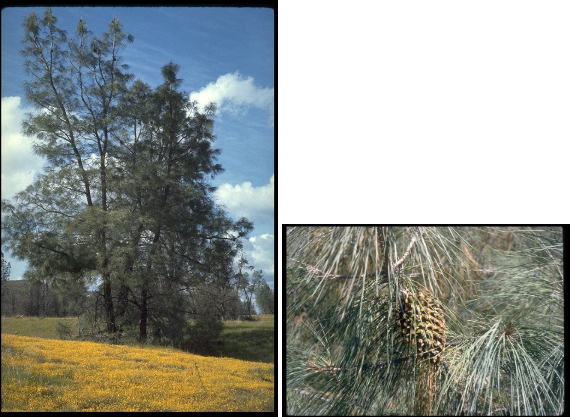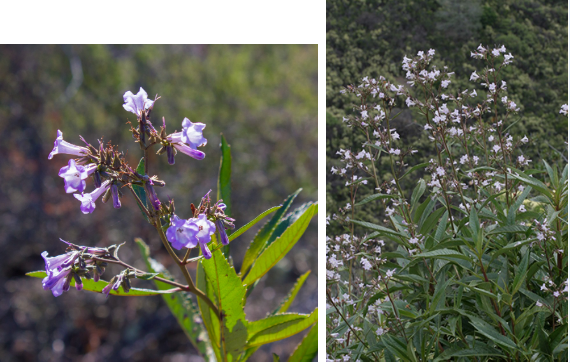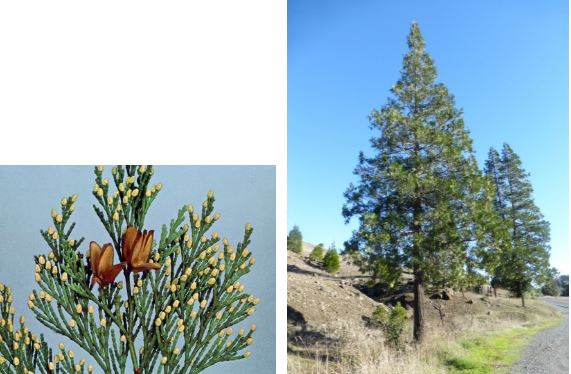
Grey pine (pinus sabiniana) is the open-branched pine with long green-gray needles and huge heavy cones. Native Americans roasted the cones and ate the nutritious seeds. Squirrels and jays also depend on the seeds of all pines, cedars, and firs. [add photo]
El pino gris (pinus sabiniana) es el pino de ramas abiertas con agujas largas de color gris verdoso y conos enormes y pesados. Las semillas asadas nutritivas estaban estimadas por los pueblos indígenas. Las ardillas y los arrendajos también dependen de las semillas de todos los pinos, cedros y abetos.

Yerba santa (Eriodictyon californicum) is a shrub whose name means “good herb”. Smell the resinous leaves. These plants have been used for general purpose medicinal uses. Plants develop strong scents and resins to prevent animals from eating them but then sometimes that strategy backfires – in this case humans used it as medicine. In spring they have purplish white or blue flowers. [add photo]
La yerba santa (Eriodictyon californicum) es un arbusto cuyo nombre significa “hierba buena” y las hojas son resinosas y huelan. Estas plantas se han utilizado para usos medicinales. Las plantas desarrollan esencias fuertes y resinas para evitar que los animales se las coman. Pero a veces esa estrategia falla; en este caso, los humanos usan yerba santa como medicina. En primavera la planta tiene flores de color blanco violáceo o azul.

Incense Cedar (Calocedrus decurrens)
This aromatic member of the cypress family grows to 150 feet and the trunks can grow to 9 feet in diameter. It’s thick, fibrous reddish-brown bark is somewhat fire-resistant. The foliage forms flat sprays that often have a vertical orientation and the leaves release a distinctive, pleasant aroma when crushed, hence the name “incense cedar”.
The cones are small and shaped like a duck’s bill. When they mature, they open, showing the open bill with its tongue sticking out.
Native Americans, including the Nisenan, used the bark for building shelters and ceremonial structures, like round houses. Pencils are often made from incense cedar and cedar chests, whose wood is used to repel moths, are also made from these trees.
Libocedro (Calocedrus decurrens)
Este miembro aromático de la familia de los cipreses crece hasta 150 pies y los troncos pueden crecer hasta 9 pies de diámetro. Su corteza gruesa y fibrosa de color marrón rojizo es algo resistente al fuego. El follaje forma rocíos planos que a menudo tienen una orientación vertical y las hojas liberan un aroma distintivo y agradable cuando se trituran, de ahí el nombre de “cedro de incienso”.
Los conos son pequeños y tienen forma de pico de pato. Cuando maduran, se abren, mostrando el pico abierto con la lengua sacada.
Los pueblos indígenas de California, incluidos los Nisenan, usaban la corteza para construir refugios y estructuras ceremoniales, como casas redondas. Los lápices suelen estar hechos de libocedro y los cofres de cedro, cuya madera se usa para repeler las polillas, también están hechos de estos árboles.
